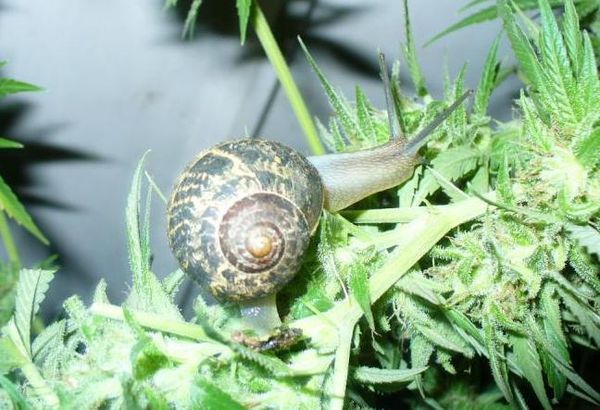- When the first rays of the sun appear in the spring, growers get down to work to begin one of the most eagerly-awaited times of year: outdoor growing season.
- Although cultivating cannabis outside boasts the advantage of not requiring all the infrastructure and energy outlays indoor growing does, the pests threatening your harvest multiply. In this post we will talk about snails and slugs, potential hazards to your outdoor crop.
- Although they move slowly and their size makes them visible to the human eye, these creatures devour plants at a dizzying rate, and are able to do serious damage to your plants.
- Do you want to know what to do to prevent this from happening? Keep on reading because we're going to tell you how to fight snails and slugs on your cannabis plants.

Snails and slugs have a viscous, soft and slippery body measuring 1 to 9 cm long, which, in the case of the former, is encased in a circular shell. They move slowly, leaving behind them a trail of very noticeable transparent and shiny mucus. Many species of snails tuck into their shells, in a spiral shape, during the winter or when the climate is too dry, and emerge to eat when the spring arrives, or when conditions are more humid, so they are frequently seen when it rains. Both snails and slugs are hermaphrodites (having both feminine and masculine reproductive organs), but they still have to copulate with another to reproduce, because they cannot fertilise themselves. The eggs of these gastropods are translucent and hatch about a month after they are laid.
How to tell whether your cannabis plants are being attacked by slugs or snails
Snails and slugs are two of the first pests suffered during the outdoor growing season. They appear in the spring, coinciding with the growth (vegetative period) of your cannabis plants; you must really be on the lookout, as this stage is when they are at their smallest and most vulnerable. Snails and slugs sleep during the day and come out to feed at night, so it is more difficult to see them if you keep a diurnal schedule. They usually hide in shadows, underneath stones, trunks, tiles… any place that provides them with dark and humid surroundings. Nevertheless, it is easy to tell whether your plants are being attacked at night by these creatures. To catch them, look out for these signals:
- Bites on the leaves, normally in a spider web shape. Note that snails and slugs feed on any type of plant matter, including roots.
- The trails of mucus they leave behind, an unequivocal signal that these annoying guests are the ones eating the leaves of your cannabis plants.
- If you're still not sure, you can look for them directly at night, with the help of a flashlight.
How to prevent and fight slugs and snails
As with any other pest that can attack your cannabis plants, the best thing you can do is prevent their appearance in the first place. Therefore, if you see that conditions are favourable for the proliferation of snails and slugs in your garden (humidity, heat), you must take preventive action to keep them from appearing.
- Don't water your plants at night. Do so first thing in the morning, thereby keeping conditions relatively dry.
- If you've already had problems with these creatures in previous seasons, avoid drip irrigation systems, and try to prevent your substrate from getting too soggy (in addition to creating an ideal atmosphere for slugs and snails, it's bad for your cannabis too).
- Create a clean and dry perimeter around your crops, and place a layer of lime, diatomaceous earth or salty sand around them. The aim is to create a barrier so that snails and slugs cannot reach your plants.
- Place a board near your plants, on the ground, leaving a little space so that slugs and snails can hide underneath it during the day. The goal is to create a trap, a comfortable place for them to take refuge from the sun's rays, so you can check during the day whether your cannabis plants may be infected.
How to fight slugs and snails on your cannabis plants
If you already have to these molluscs running amok on your cannabis crop, act fast and effectively to keep them from feasting on your plants:
- If you did not do so previously, now is the time to create that barrier we mentioned previously. Even if your plants are already infected, once your cannabis pests have been eliminated, this will prevent the same situation from happening again (as far as possible, as it's not infallible).
- Construct a trap to catch the slugs and snails: make a small hole in the ground and place in it a container containing beer and jam; the scent of this mixture will attract these molluscs, who will fall into the concoction and drown. Put several of these traps around your plants.
- Biological control: the predatory slug Ruminia decollata is available commercially, and is another way to combat snails and slugs, as it is feeds avidly on them. Keep in mind that it can help, but it´s not a definitive solution to the problem.
- Manual cleaning: manually eliminate the snails and slugs. You will want to do this at night, when they emerge from their hiding places to feed, and with the aid of a flashlight.
- There also exist a multitude of poisonous baits that you can easily find on the market. Be careful with these types of product if you have pets or children at home. The safest way to use them is to place them in a plastic container, and make a small hole so that the snails and slugs can get in.



Comments from our readers
Read comments in other languages:
Did you like this post?
Your opinion about our seeds is very important to us and can help other users a lot (your email address won't be made public).